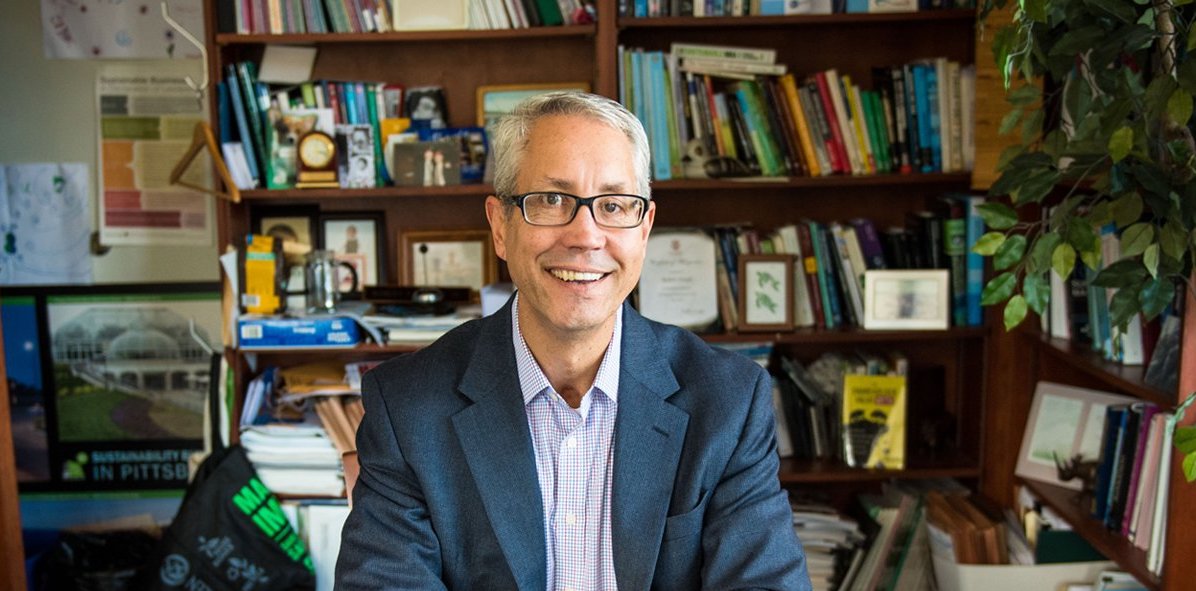Podcast: Play in new window | Download | Embed
Robert Sroufe, PhD. is a Professor of Sustainability, Operations and Supply Chain Management at Duquesne University. His practical experience comes from sustainable supply chain management. He says he was ‘co-opted’ into the green building movement by other experts who invited him to present to their students about the business opportunities of sustainable building.
Customised Sustainability
Robert acknowledges that the concept of sustainability is very broad. He refers back to the Brundtland definition. This basically translates to meeting our needs today, without compromising the needs of future generations. It’s a good overarching philosophy but is not very actionable.
Using a strategic sustainable development framework, Robert is able to ‘define and operationalise’ what sustainability means. The framework can be applied to any specific organisation, process, or even a building. This is useful because it provides specific actions for achieving individual sustainability goals.

Five Level Framework of Sustainability
During our chat, Robert introduced his five level framework of sustainability. This can definitely be applied to a sustainable building project.
1. Systems
Start by understanding what systems are in place, or what needs to be in place. In a building, this could include physical systems such as the structure, the control layers of the building envelope, or the electrical or plumbing systems. It could also include financial and regulatory systems.
2. Success
What does success mean for the organisation or project? This is a key step when considering buildings. A shareholder in a property development company may have a different definition of success than an owner-occupier concerned with the health and wellbeing of their family or staff.
3. Strategy
Once success is defined, it’s time to get strategic. How is sustainability success going to be achieved? In the case of a building, this might be deciding between renovating an existing building or starting from scratch. Is a rating, certification or standard going to be applied to the building? If so, which one?
4. Actions
Action is the realm of traditional project management. Think Gannt charts. Discreet steps and activities can be clearly defined and assigned. For a building project, this would involve coordinating the various contractors and sequencing of the design, procurement, construction and compliance processes.
5. Tools
Robert defines the fifth and final part of the framework as the tools for the job. Tools are not just the physical tools of the trade. They might also include decision-making tools. In the case of a Passive House building project, the Passive House Planning Package (PHPP) software is one such tool. PHPP enables the designer to test a multitude of scenarios and solutions before any purchasing decisions are made.
A-B-C-D Planning Process of Sustainable Building
Robert explains a planning process that is embedded within the strategic sustainable development framework. Again, this process can be readily applied to the development of sustainable buildings.
- Awareness of opportunity. We need buildings. How can we make really good ones?
- Baseline information. How do current buildings perform and how do we need them to perform?
- Creative solution. How can we get from our baseline, to where we want to be?
- Down to action. Get people onboard and get on with it!
Creating Value for Community
I asked Robert about the role of corporations and the responsibility of boards to look after the short term interests of shareholders. Stated as the fiduciary duty of a company, this has been misconstrued over the last century. Companies don’t have to always put short term profits before long term sustainability.
Where Change Comes From
Robert is optimistic that change is coming from all directions and all levels. From financiers through to consumers and the c-suite to main street, there is evidence that more people are basing decisions on longer term sustainability. If this is the message being taught to Robert’s students, or indeed the sentiment Robert is hearing back from younger generations, then the future is looking promising.
Sustainable Building is Driven by Business
Policymakers tend to follow industry and markets, explains Robert. We should take note of this in the building sector. We want the building code to improve and I’m certainly guilty of doing my fair share of complaining about this matter. A more productive approach, however, is for us in the industry to lead the change. By being the change we want to see, we can give policy makers confidence to be bold.
Buildings are Really Important
Dr Sroufe reminds us just how important our work is to design, construct and maintain good quality buildings. The built environment currently contributes a significant amount to overall greenhouse emissions. We can design this out of the system.
Buildings are systems that are interconnected with other systems. Transport, communications, power and utilities systems all need to work together to create livable places. Robert points to ‘the internet of things’ as increasing the importance of buildings within the network of urban infrastructure.
Buildings are also incredibly important by virtue of how much time we spend inside them. Robert estimates that the average fifty year old today has spent forty five years of their life inside a building.
Sustainable Building is Above Code
“Building to code is probably the riskiest building you could build”, says Robert. It’s the building that exposes everyone to the most legal liability and it won’t be energy efficient. He says that, at least in America, it’s increasingly possible to build and a high-performance building at, or near the same cost as building just to meet code compliance. So why would you not build high performance?
The Barrier of Abundance
In Western culture, we’ve become used to abundance and this oversupply leads to a lot of waste. Robert cites the energy sector in the US as one example, where 67% of the energy generated is wasted. In the transportation system, 80% of the energy from fuel is wasted. Our systems of constructing, living in and maintaining our buildings are equally wasteful. If we seek truly sustainable buildings, we need to address waste.
When it comes to our homes and buildings, we usually focus on what Robert terms ‘first costs’. We disregard or dimmish the total operating costs which are significant over the life of the building.
Renovating to Net Positive
Robert did a good retrofit of his own home and added his own electricity generation. As a result, he now lives in a net positive home. While his neighbours are paying hundreds of dollars per month on utility bills, Robert pays $15 to cover his connection. His house provides power to his electric vehicle.
This is a great example of how such a renovation can be done to create a sustainable building. So good in fact, that Robert has written a book about it.
However, it’s alarming that the house needed to be renovated at all. It was less than two years old before he set about tightening up the envelope and adding some insulation. It now consumes 50% less energy and 30% less water than the average home in Pennsylvania, despite being one and half times larger.
Free Blower Door Test
Many of the efficiency and comfort improvements for Robert’s house came from tightening up the building envelope. He sealed a lot of gaps that were left during construction and was able to quantify this work with a Blower Door test. The test was provided free of charge by Robert’s utility company. A Blower Door combined with an infrared camera enabled Robert to easily identify the worst leaks in the envelope. These are the places where he could get the most benefit by sealing. It would be great to see utility company subsidised Blower Door testing available everywhere to improve the practice of sustainable building!
Resources
Dr. Robert Sroufe
Dr Robert Sroufe is the Murrin Chair of Global Competitiveness at Duquesne University in Pittsburgh. He’s a Professor of Sustainability, Operations and Supply Chain Management in the Sustainable Business Practices MBA program. As the curriculum lead for sustainability within the Palumbo-Donahue School of Business, Dr Robert Sroufe has helped this innovative program become the number ranked MBA Sustainable Business Practices program in the US. Dr Sroufe’s Sustainability Tools and Processes for New Initiatives course became one of just 20 selected internationally by the Aspen BSP as one of its Ideas Worth Teaching Award winners. The Production and Operations Management Society along with the Academy of Management, have also acknowledged Dr Sroufe’s thought leadership and teaching.
Dr Sroufe is an author of a number of books. His most recent publication, The Power of Existing Buildings: Save Money, Improve Health, and Reduce Environmental Impacts, explains why existing buildings can and should be retrofitted to reduce environmental impacts that contribute to climate change while improving human health and productivity for building occupants. This step-by-step guide will challenge readers to rethink spaces where people work and play while determining how existing buildings can ultimately save the world.



Leave a Reply